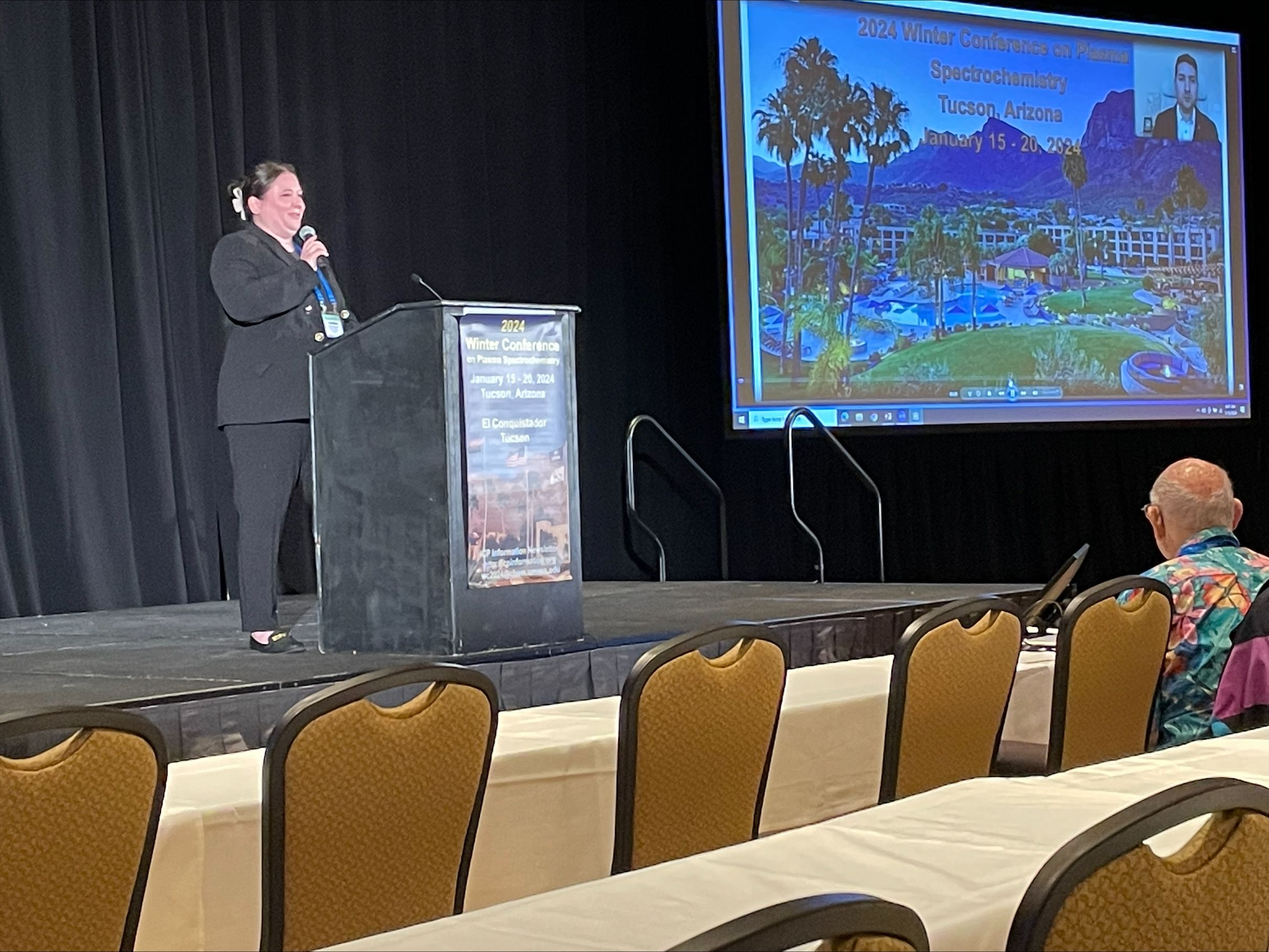Spectroscopy’s Emerging Leader in Atomic Spectroscopy: A Look at ICP-MS Analysis of Nanostructures
On Monday January 15th at 8 am local time, Eduardo Bolea-Fernández of the University of Zaragoza, in Zaragoza, Spain, was recognized as Spectroscopy’s Emerging Leader in Atomic Spectroscopy for 2024. Here’s a recap of this award session.
This morning, the Winter Conference on Plasma Spectrochemistry kicked off with and award presentation. Associate editorial director of Spectroscopy, Caroline Hroncich, presented the annual Emerging Leader in Atomic Spectroscopy award to Eduardo Bolea-Fernández of the University of Zaragoza.
Spectroscopy magazine editorial director Caroline Hroncich congratulating Eduardo Bolea-Fernández for winning the Spectroscopy Emerging Leader in Atomic Spectroscopy Award. | Photo Credit: © Will Wetzel

Dr. Bolea-Fernández was unable to attend this year’s conference because of an illness, but his work was talked about extensively, cementing his inclusion as one of the youngest and brightest leaders in the field of inductively coupled plasma–mass spectrometry (ICP-MS) analysis. In a pre-recorded talk, Bolea-Fernández discussed his research, which focuses on fundamental measurement methodologies in nanotechnology using ICP-MS instrument configurations (1).
“In our research, ICP-MS is at the center and can be considered the core of our activities. We apply high-end method development to address various scientific disciplines from an interdisciplinary perspective,” Bolea-Fernández told Spectroscopy (1).
ICP-MS is indeed at the forefront of elemental and isotopic analysis (2). Bolea-Fernández’s plenary lecture explored how single-event ICP-MS has only accelerated analysis in this field. He focused on three applications during his talk: nanoparticles, cells, and microplastics. Explaining how ICP-MS has transformed as a technique during his time in the field, Bolea-Fernández presented how improvements in ICP-MS instrumentation led to the creation of single-event ICP-MS, and how the technique allows more thorough analysis than traditional ICP-MS.
When it comes to measurement protocol, Bolea-Fernández explained the benefits of using single-event ICP-MS over ICP-MS bulk analysis. Whereas in ICP-MS bulk analysis, where there is a stable signal and slow data acquisition speed, single-event ICP-MS has a transient signal, which results in data being acquired much more quickly (3). The benefit of using single-event ICP-MS allows the analyst to gain more insights into discrete entities (these include engineered nanoparticles [ENPs], microplastics, and cells) and as a result, get a more comprehensive analysis of the spectral data (3). Meanwhile, ICP-MS bulk analysis provides a general, big picture overview of the spectral data.
The most interesting part of his talk when he presented his work using SC-ICP-MS/MS to analyze human cancer cells, and how this atomic spectroscopic technique could advance oncology research. Bolea-Fernández explained how he and his team looked at assessing intracellular platinum (Pt) levels resulting from cisplatin exposure at the single-cell level. They observed that the Pt mass per cell increases linearly with the increasing concentration of the cisPt solution the cells are exposed to. The evaluation of the cytotoxic effects of cisPt by evaluating the adenosine triphosphate (ATP) content showed that the metabolic activity of Jurkat cell line was inhibited by cisPt treatment while little response was observed for Raji and Y79 cell lines (4). The findings showed that SC-ICP-MS/MS had potential for quantifying endogenous metal content in individual cells at the fg level (4).
When it comes to measurement protocol, Bolea-Fernández explained the benefits of using single-event ICP-MS over ICP-MS bulk analysis. Whereas in ICP-MS bulk analysis, where there is a stable signal and slow data acquisition speed, single-event ICP-MS has a transient signal, which results in data being acquired much more quickly (4). The benefit of using single-event ICP-MS allows the analyst to gain more insights into discrete entities (these include engineered nanoparticles [ENPs], microplastics, and cells) and as a result, get a more comprehensive analysis of the spectral data. Meanwhile, ICP-MS bulk analysis provides a general, big picture overview of the spectral data (4).
Therefore, this opening presentation was a good segue into further discussion on ICP-MS during the conference. Bolea-Fernández’s work with ICP-MS and single-cell analysis advances required using data-driven approaches and interdisciplinary collaboration, and his research could be applied in various application where elemental analysis is required, including environmental interactions and targeted therapies (1).
References
- Workman, Jr., J. The 2024 Emerging Leader in Atomic Spectroscopy Award. Spectroscopy 2024, 39 (1), ASAP.
- T. Van Acker, S. Theiner, E. Bolea-Fernandez, F. Vanhaecke and G. Koellensperger, Nat. Rev. Method. Prim. 2023, 3 (52) (2023).
- Resano, M.; Aramendía, M.; García-Ruiz, E.; Bazo, A.; Bolea-Fernandez, E.; F. Vanhaecke, F. Chem. Sci. 2022, 13, 4456.
- Bolea-Fernández, E. Revealing the Invisible: Single-Event ICP-MS Analysis of Micro/Nano-Structures. Presented at the Winter Conference on Plasma Spectrochemistry 2024, Tucson, Arizona, January 15th, 2024.
How Do We Improve Elemental Impurity Analysis in Pharmaceutical Quality Control?
May 16th 2025In this final part of our conversation with Harrington and Seibert, they discuss the main challenges that they encountered in their study and how we can improve elemental impurity analysis in pharmaceutical quality control.
High-Speed Laser MS for Precise, Prep-Free Environmental Particle Tracking
April 21st 2025Scientists at Oak Ridge National Laboratory have demonstrated that a fast, laser-based mass spectrometry method—LA-ICP-TOF-MS—can accurately detect and identify airborne environmental particles, including toxic metal particles like ruthenium, without the need for complex sample preparation. The work offers a breakthrough in rapid, high-resolution analysis of environmental pollutants.
The State of Forensic Science: Previewing an Upcoming AAFS Video Series
March 10th 2025Here, we provide a preview of our upcoming multi-day video series that will focus on recapping the American Academy of Forensic Sciences Conference, as well as documenting the current state of the forensic science industry.

.png&w=3840&q=75)

.png&w=3840&q=75)



.png&w=3840&q=75)



.png&w=3840&q=75)





